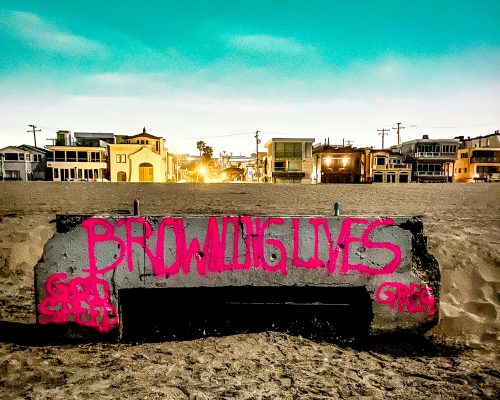
After a tumultuous 2015, the future of the Redondo Beach waterfront appears to have cleared up, ever so slightly.
Despite a defeated ballot measure that some feared would result in guaranteeing the AES power plant’s retention into the future, the power plant’s land is on the market, the result of an agreement between the City of Redondo Beach and its longtime power generating tenants.
Meanwhile, El Segundo-based developer CenterCal Properties released plans for its Waterfront redevelopment project — a project that would level much of the existing harbor and pier areas in hopes of creating a new, more vital Redondo Beach waterfront.
Power plant potential
For a while, it appeared the citizens of Redondo Beach had found a way to make sure that one of the city’s most contested pieces of property — the 50-acre plot of land under the AES Redondo Generating Station — would stick around at least for the foreseeable future, despite years of fighting to get rid of it.
March 3’s General Election election ballot was headlined by Measure B, a zoning proposal crafted by AES that would have rezoned the land under the power plant away from industrial use to mixed-use zoning, allowing for the construction of residential, retail and office spaces.
Called the Harbor Village plan, the proposal garnered widespread support throughout the city, including from Redondo Beach Mayor Steve Aspel, who helped broker the deal with AES in a 2014 surprise.
Aspel, after years of agitation, made peace with AES and threw his support behind the company’s proposal to get rid of the power plant. “It will provide absolute certainty that we will have a waterfront free of the power plant and all industrial development,” he said at the time.
But Measure B was challenged by both civic leaders, such as District 2 councilman Bill Brand, and grassroots organizers Todd Loewenstein, of Redondo Residents for Responsible Revitalization, and Jim Light, of Building a Better Redondo.
Measure B’s opponents argued proposed project was too big and too dense, with the potential to generate unsustainable amounts of traffic for the area, according to traffic calculations produced by Light. Harbor Village, he said, would have added 11,269 daily weekday car trips and 12,391 daily weekend trips to the area.
The measure’s opposition also accused AES of making backroom deals, cutting the public out of discussions entirely. “They basically abused what is a citizen’s initiative process to get what they want,” Brand said.
Brand believed that the plant would be gone within a few years anyway. State regulations would force the plant to upgrade its current generators by 2020, and a plant redesign would require certification of the plant from the state energy commission — that, Brand believed, was far from a slam-dunk for AES.
Their arguments held. Measure B was defeated in March, 52.4 percent to 47.6 percent. “I’m stunned, actually,” said AES Southland vice president Eric Pendergraft, who spearheaded the Yes on B campaign. “I thought it was going to be close, but at the end of the day people would vote for progress.”
Pendergraft indicated that AES could look to building a water desalination plant or a battery storage facility should its attempt at certifying a new plant go south.
A few weeks later, Aspel announced at his State of the City address that a citizen-based task force would be formed to determine the best possible plan for the AES site. While discussions as to the task force’s formation moved along, the City Council moved to take intervenor status in AES’s application for a new plant, as they had in years past.
As part of that effort, the council considered changes to the city’s coastal zoning ordinances, drawing AES’s power plant application into conflicts that state commissions tend to side with civic governments in.
However, both efforts were put on hold in early November, when AES and the city brokered a deal that put the power plant land on the real estate market.
On Nov. 3, City Attorney Michael Webb announced that the city and the power company would sent letters to the California Energy Commission and the South Coast Air Quality Management District, requesting that both suspend work on AES’s application for a new plant.
The power company also agreed to put the land on the real estate market immediately, searching for non-industrial uses.
For its part, the city is suspending work on its task force until July, aiming to help AES in marketing the land.
“Basically, peace has broken out,” Webb said after the meeting. “That doesn’t mean its lasting, but it’s an opportunity to have everyone work together, to have the property owner find something that is of value to them, and for the members of the public and the council, through the task force, to find something that protects the interest of the residents of Redondo.”
The agreement appears to be a significant step forward in a dispute that has dogged the city for the better part of two decades. But as is so often true on the waterfront, nothing is set in stone.
“This is something that both the City and AES agreed to, but it’s not an end-all,” Aspel said in November. “If something goes sideways between now and summer, we’ll have to go back to fighting them again.”

Waterfront lines
Most Redondo Beach residents agree that the city’s waterfront area, including King Harbor, the Redondo Pier and the International Boardwalk, has been sorely in need of revitalization for years.
The waterfront, CenterCal CEO Fred Bruning said, is “run down, and it’s time to fix it.”
Bruning’s company, which has exclusive negotiating rights with the City of Redondo Beach in the wake of the 2010 passage of Measure G, aims to add 304,058 square feet of net new development to the oceanfront property between Portofino Way and Torrance Boulevard, including the construction of a 130-room hotel, a market hall, a specialty movie theater, retail and office spaces.
CenterCal’s Waterfront, which is projected to cost $300 million, would also rebuild the city’s deteriorating parking structures and transform the Seaside Lagoon into a small beach and actual lagoon that would open into King Harbor.
Many of these specifics came to light with the release of the project’s Draft Environmental Impact report in November. The report, prepared by city staff, listed only two unavoidable, unmitigatable impacts: tsunami danger, which already exists as a function of the area sitting along the Pacific, and an unavoidable increase in ambient noise levels from the project’s success at attracting more activity.
Bruning called the report’s findings “one more confirmation that we are on the right track in revitalizing the Redondo Beach waterfront and making it a place the whole community can enjoy.”
Jim Light wasn’t so sure. He, along with members of an organization called Rescue Our Waterfront, believe that the proposed project is too large, too dense, and generates too much traffic.
Meetings of the organization have outlined project details, Light’s objections to the DEIR (of which he has enough to fill a book, he’s said), philosophical discussions about what should be built down there, and potential steps to take against the project. Those considered steps range from appeals and ballot initiatives to potential lawsuit against the project.
“Our goal was to give the community information on the impact of the project and to allow people to ask questions that they had,” said ROW co-founder and former District 3 council candidate Candace Nafissi.
While project opponents war about the Waterfront’s potential, city-commissioned studies have found that the project is likely to be an economic boon for the region. In February, a city-commissioned study by AECOM determined that the proposed project would fill demands for a destination marketplace in the South Bay, meeting or exceeding expectations in retail, office and boutique hotel markets.
Coming into AECOM’s presentation, Aspel feared the company’s analysis would be a waste of money, telling the city something they already knew about the project’s money-generating potential — or worse, that the Waterfront project would be a financial boondoggle. Instead, the analysis found the project to be “even more successful than staff said it would be,” he said.
As for the Draft EIR, the public has until Jan. 19 to send comments, questions and concerns to the city for review before the report is reviewed and finalized.









